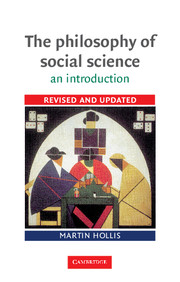Book contents
- Frontmatter
- 1 Introduction: problems of structure and action
- 2 Discovering truth: the rationalist way
- 3 Positive science: the empiricist way
- 4 Ants, spiders and bees: a third way?
- 5 Systems and functions
- 6 Games with rational agents
- 7 Understanding social action
- 8 Self and roles
- 9 Explaining and understanding
- 10 A value-neutral social science?
- 11 Rationality and relativism
- 12 Conclusion: two stories to tell
- Bibliography
- Index
11 - Rationality and relativism
Published online by Cambridge University Press: 03 July 2012
- Frontmatter
- 1 Introduction: problems of structure and action
- 2 Discovering truth: the rationalist way
- 3 Positive science: the empiricist way
- 4 Ants, spiders and bees: a third way?
- 5 Systems and functions
- 6 Games with rational agents
- 7 Understanding social action
- 8 Self and roles
- 9 Explaining and understanding
- 10 A value-neutral social science?
- 11 Rationality and relativism
- 12 Conclusion: two stories to tell
- Bibliography
- Index
Summary
If there are no facts prior to interpretation, must claims to knowledge of the world always be relative to some set of beliefs held at a particular time and place? That is the problem of knowledge as it emerged in earlier chapters. If action is to be understood by rationally reconstructing its meaning from within, we have a 'double hermeneutic' and a further shove towards relativism. The problem of Other Minds takes on daunting form. Yet, even if daunting in the abstract, it seems easy enough in practice. People often succeed in communicating what is in their minds. Barriers of culture and period make the task harder. But archaeologists perform it, when they reconstruct an ancient city from ash, bone and broken pottery. Historians perform it, when they read the story of feudalism from old parish registers and other archives. Anthropologists perform it, when they penetrate a distant language and culture and discover, for instance, that the Azande believe in witches or that the Nuer classify human twins as birds.
How is it done? Here are two conflicting lines of thought. One is that, since different peoples inhabit intellectual worlds very unlike our own, the key is to be entirely open-minded about what an enquiry may find. The other is that we could not chart these differences, nor justify a claim to have done so correctly, unless we could rely on Other Minds to be basically like us; so the key is to make these similarities our bridgehead. One line leads to some version of relativism, the other to some version of universalism. Which is right or whether they can be combined is a matter of fierce debate and crucial for the proper character of social science.
- Type
- Chapter
- Information
- The Philosophy of Social ScienceAn Introduction, pp. 224 - 247Publisher: Cambridge University PressPrint publication year: 1994



